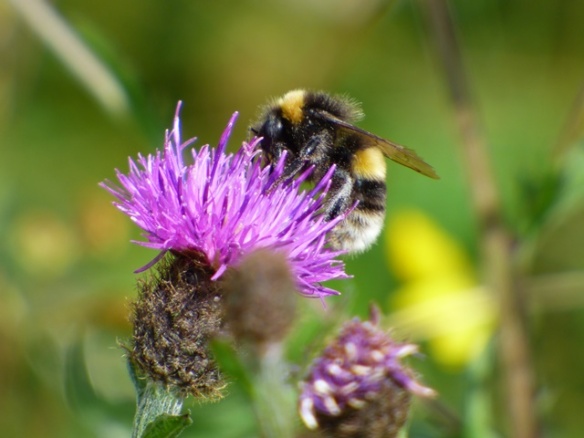The end of the year approaches, winter’s grip tightens. How about a festive treat, reflecting on the lovely days of summer when pollinators were around? At Forvie National Nature Reserve the team installed a pollinator trail and it proved a big hit, especially in the August sunshine when Dave Pickett penned this blog.
Pollinators need our help. And we need them. They are the bunch of insects mostly bees, hoverflies and some flies, that help with the pollination of flowers. There is real pleasure in seeing pollinators work away on flower heads and listening to their sounds. But they are more than something nice to look at, they play a vital role in our food and farming industries.

But wild pollinators are in trouble. They suffer from fragmentation of habitat, changes in the way land is used, diseases, use of pesticides and also climate change.
However, we can help them. At Forvie we have a meadow managed specifically to provide food for pollinators. It has developed over a number of years and now is managed to best suit the wildflowers – by cutting late in the year and then raking and removing the cuttings. This allows the flowers to be there for the insects to use and then set their seed before the plants are cut. By removing the cuttings we stop the bigger, tougher, ranker plant species taking over.

And now we have a trail set up at the visitor centre, with information boards around the meadow explaining more about pollinators and what everyone can do to help. It is worth lingering around the trail as there is a real buzz (ha ha – see what I did?) about the place – bumblebees, hoverflies and a host of others working the sea of flowers. As well as pollinators there are a mass of butterflies using the flower heads as well. You will see that the plantings actually go all round the car park too, and when you arrive it gives you a genuine ‘nature reserve sense of arrival’. So though Forvie is a huge site you don’t actually have to go very far to get up close to nature.
There is loads more information on pollinators, and what you can do to help, here on the SNH website. Why not have a look and see what you can do?





Enjoy that? Well, the eagle-eyed amongst you will know that Dave was working on a six-month secondment at Forvie and is more often associated with Flanders Moss National Nature Reserve … where he has also installed a pollinator trail. So as an extra treat, here’s a reminder of Dave’s reflection on the pollinator trail near Stirling back in the height of summer:
A welcome meadow for pollinators and people
The wildflower meadow at the Flanders Moss car park has been looking good this summer. Or at least until the fierce sun and lack of rain caused it to brown off a bit.
The meadow has been developed over the last three years, following the landscaping of the car park, and it acts as an attractive welcome to the reserve — but there is much more to it than just that.


Firstly, the mix of wildflowers is the same as would have been found historically on the hay meadows all around Flanders. A century ago there would have been hundreds of flower filled meadows but through agricultural intensification the flowers have been lost from them.
This loss of habitat, and other factors like pesticide use and climate change, have reduced populations of pollinators such as like bees and hoverflies, and these are important insects having crucial roles in farming and food industries. So every chance to restore a small area of habitat for these attractive insects should be taken.
This summer has seen good numbers of honey bees, bumblebees, hoverflies and butterflies using the various wildflowers that are starting to appear.
And most exciting of all was the appearance of the rare day flying moth, the beautiful Argent & Sable, making use of the buttercups, and providing a real seal of approval for all of the work put in by volunteers and staff alike.

The meadow at Flanders has been developed through planting a mixture of wildflower plugs but also through collecting seed from wildflower species such as knapweed, meadow vetchling, and yellow rattle, from sites nearby. In line with the traditional way of management the meadow will be cut in the autumn to remove the vegetation layer and open up gaps for seeds to germinate.
Below are some images of the pollinators helping themselves.








